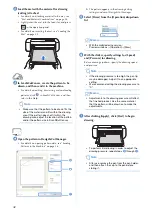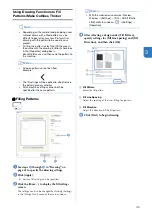
49
3
c
Place the included calibration sheet on a flat
surface, and then photograph it from directly
above.
Save the photo to the computer.
Memo
•
You can print the calibration sheet with your
printer by clicking [Print the calibration sheet.].
•
With the mobile device version; tap [Calibration]
and photograph the calibration sheet.
*
1
Photographed area
Note
•
Take the photo in a well-lit location.
•
Before taking the photo, wipe the camera lens
with a soft dry cloth, and make sure that the
lens is not dirty.
•
When photographing, make sure that there are
no objects or shadows on the paper.
•
If the calibration sheet is dirty or folded, print a
new copy of the calibration sheet and take a
photo of the new sheet.
•
When photographing, do not zoom or use a
flash.
d
Click [Select], and then select the image saved
in step
.
The name of the imported image appears in the
box.
Note
• The only image files that can be used are JPG
files.
e
Under [2.Please input your camera name.],
type in the name of the camera.
Memo
• Depending on your camera, its name may
automatically be entered when the image is
selected in step
f
Click [OK].
The following message appears.
Memo
• The next time “CaptureMat” function is used,
repeat steps
to register new
camera (if the image that will be used was
photographed with a camera different from the
one that was registered).
■
Image correctly
photographed
Make sure to capture all of
the dots in the calibration
sheet and only capture the
dots in the calibration
sheets.
■
Camera too close to
paper
If the camera is too close
to the paper, calibration
will not be performed
correctly.
■
Camera too far from
paper
If the camera is too far
away from the paper,
calibration will not be
performed correctly.
■
Paper at an angle
If the camera and paper
are misaligned, calibration
will not be performed
correctly.
a
a
a
a
















































